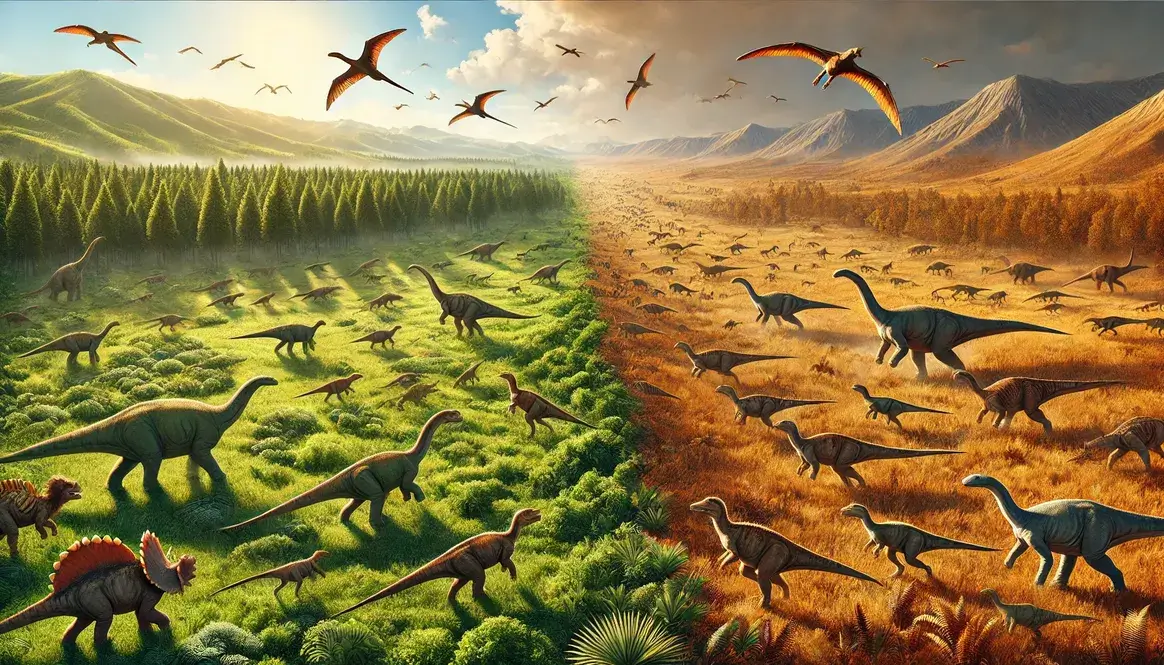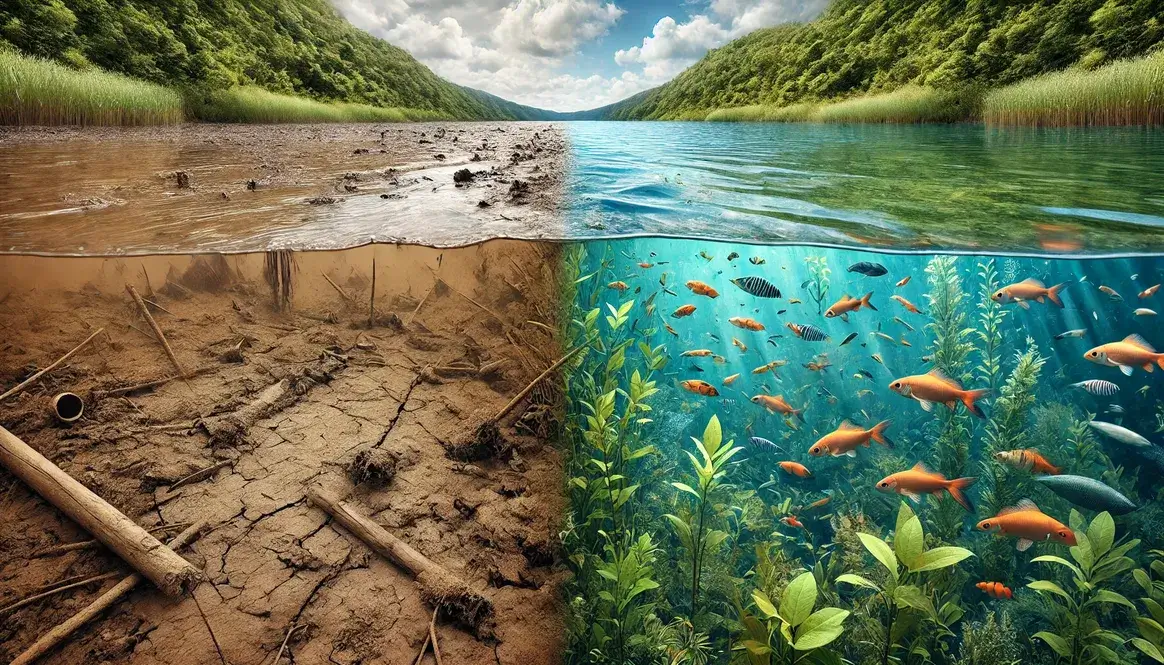When we think about dinosaurs, we often picture them in one place, like a tropical jungle or a dusty desert. But these ancient animals weren’t always stay-at-home creatures. Like many animals today, dinosaurs moved around their environments. One big reason for these prehistoric journeys? Climate.
Climate played a huge role in shaping where dinosaurs lived and how they behaved. Just as birds fly south for the winter or elephants search for water during dry seasons, dinosaurs likely moved in response to changing weather patterns and long-term climate shifts.
| Key Facts About Dinosaur Climate Migration | Details |
|---|---|
| Evidence Types | Fossil distribution, bone chemistry, trackways |
| Main Climate Factors | Temperature changes, rainfall patterns, sea level fluctuations |
| Migration Types | Seasonal movements, long-term climate change responses |
| Comparison to Modern Animals | Similar triggers to bird and mammal migrations |
| Notable Examples | Duck-billed dinosaurs in North America |
Did Dinosaurs Migrate Due to Climate?
Yes, evidence suggests that dinosaurs did migrate due to climate changes. Scientists have found several clues that point to climate-driven dinosaur migration:
- Fossil locations: Dinosaur remains have been found in places that had very different climates during the Mesozoic era, suggesting these animals moved between regions.
- Bone chemistry: By studying the chemical makeup of dinosaur bones, researchers can tell what kind of environment the animal lived in at different times of its life.
- Footprint trails: Long lines of dinosaur tracks sometimes show animals moving in the same direction, hinting at group migrations.
These pieces of evidence tell us that dinosaurs weren’t just wandering aimlessly. They were likely responding to changes in their environment, much like animals do today. When the weather got too hot, cold, wet, or dry, dinosaurs probably packed up and moved to more comfortable areas.
For example, some scientists think that duck-billed dinosaurs in North America might have traveled hundreds of miles each year to find better food and nesting spots as the seasons changed. This behavior isn’t too different from what we see in modern-day caribou or wildebeest.
Understanding how dinosaurs responded to climate changes in the past can even help us think about how animals might react to climate change today. It’s like looking at a very old, very big history book of animal behavior!
Climate Factors Triggering Dinosaur Migration
Just like modern animals, dinosaurs had to deal with various climate factors that influenced their movement. Let’s explore the main climate-related reasons that might have caused dinosaurs to pack their imaginary bags and hit the road.
Temperature Changes
Seasonal temperature shifts played a big role in dinosaur migration. As the Earth’s tilt caused seasons to change, some areas became too hot or too cold for comfort. This likely prompted dinosaurs to move to more suitable climates.
Evidence from fossil records supports this idea:
- Growth rings in bones: Similar to tree rings, some dinosaur bones show growth patterns that suggest seasonal changes in food availability and temperature.
- Fossil distribution: Arctic dinosaur remains indicate that some species migrated to polar regions during warmer months and possibly returned to lower latitudes in winter.
For example, duck-billed hadrosaurs might have traveled between coastal plains and inland areas as temperatures fluctuated. Their fossils have been found in a wide range of latitudes, suggesting they were adaptable to different climates.
Rainfall Patterns
Changes in rainfall had a significant impact on dinosaur food sources, which in turn affected their migration patterns. During dry seasons, vegetation would become scarce in some areas, forcing plant-eating dinosaurs to move in search of greener pastures. Meat-eaters would follow their prey, creating a chain of migration.
Some dinosaur species that likely migrated due to rainfall patterns include:
- Sauropods: These long-necked giants needed vast amounts of plant material to survive. They may have followed seasonal rains to find fresh growth.
- Ornithomimids: These ostrich-like dinosaurs were probably omnivores and might have moved to areas with more diverse food sources during dry periods.
Interestingly, Cretaceous weather patterns were often more extreme than today, with intense monsoons and long dry spells. This would have made rainfall-driven migration even more crucial for dinosaur survival.
Sea Level Fluctuations
Rising and falling sea levels had a profound effect on dinosaur habitats, especially for coastal-dwelling species. These changes could create or destroy land bridges, open up new territories, or submerge familiar lands.
| Sea Level Change | Impact on Dinosaurs |
|---|---|
| Rising sea levels | Forced inland migration, reduced coastal habitats |
| Falling sea levels | Exposed new land for exploration, connected previously isolated areas |
Evidence of dinosaur migration in response to coastal changes includes:
- Fossil remains of typically inland species found in what were once coastal areas, suggesting they moved as shorelines advanced.
- Trackways showing dinosaur movement away from or towards ancient coastlines.
The Cretaceous sea levels were much higher than today, which meant that sea level changes had an even greater impact on dinosaur habitats and migration patterns.
Understanding these climate factors helps us piece together the complex puzzle of dinosaur behavior and adaptation. It’s amazing to think that these ancient creatures responded to their changing world in ways not so different from animals today!
Types of Climate-Induced Dinosaur Migration
Just as modern animals have different migration patterns, dinosaurs likely had various ways of moving in response to climate changes. Let’s explore two main types of climate-induced dinosaur migration: seasonal and long-term.
Seasonal Migration
Seasonal migration involves regular, annual movements that follow predictable climate patterns. These journeys helped dinosaurs find food, suitable nesting grounds, and comfortable temperatures throughout the year.
Examples of dinosaur species that likely engaged in seasonal migration include:
- Hadrosaurs: These duck-billed dinosaurs might have migrated between coastal and inland areas as seasons changed.
- Pachyrhinosaurus: Fossil evidence suggests these horned dinosaurs may have migrated to and from polar regions.
- Edmontosaurus: Large bone beds of this hadrosaur indicate possible seasonal gatherings for migration.
Seasonal migration patterns were likely influenced by the Earth’s orbital effects on climate. As the planet’s tilt and orbit changed throughout the year, it created seasonal variations in temperature and daylight, much like we experience today.
Here’s a simple breakdown of how seasonal migration might have worked for some dinosaurs:
| Season | Migration Activity |
|---|---|
| Spring | Move to breeding grounds |
| Summer | Spread out to feeding areas |
| Fall | Gather for southward journey |
| Winter | Stay in warmer southern regions |
Long-Term Climate Change Migration
While seasonal migration happened yearly, long-term climate change migration occurred over much longer periods. Gradual shifts in climate over thousands or millions of years forced dinosaurs to adapt by slowly changing their ranges.
These long-distance movements were likely caused by factors such as:
- Shifting continental positions
- Changes in ocean currents
- Variations in atmospheric carbon dioxide levels
As the climate slowly changed, plant life would have shifted as well. Herbivorous dinosaurs would have followed their food sources, and carnivores would have followed their prey. This gradual movement could have led to significant changes in dinosaur distribution over time.
Fossil evidence supporting long-term migration patterns includes:
- The discovery of similar dinosaur species on different continents, suggesting they moved as landmasses shifted.
- Changes in the geographic range of certain species over geological time periods.
- Adaptations in dinosaur anatomy that suggest adjustments to new environments over time.
For instance, some scientists believe that sauropod dinosaurs might have spread from South America to other continents as the climate became more favorable in new areas. This long-term migration would have taken place over millions of years as the supercontinent Pangaea broke apart.
Understanding these different types of migration helps us paint a more complete picture of how dinosaurs lived and adapted to their ever-changing world. It’s a reminder that, just like animals today, dinosaurs were dynamic creatures, always on the move in response to their environment.
Evidence Supporting Dinosaur Climate Migration
Scientists have pieced together evidence from various sources to support the idea that dinosaurs migrated due to climate changes. Let’s explore three main types of evidence: fossil distribution patterns, bone chemistry analysis, and trackway evidence.
Fossil Distribution Patterns
The way dinosaur fossils are spread across the globe tells us a lot about how these ancient creatures moved. Widespread fossil finds often indicate that dinosaurs weren’t staying in one place but were on the move, possibly due to changing climates.
Specific examples of fossils supporting migration theories include:
- Edmontosaurus: Fossils of this duck-billed dinosaur have been found from Alaska to Colorado, suggesting a north-south migration pattern.
- Protoceratops: This small horned dinosaur’s remains have been discovered across a wide range of latitudes in Asia, hinting at possible climate-driven movements.
These distribution patterns are particularly interesting when we consider the Cretaceous period climate. The warmer global temperatures during this time might have allowed dinosaurs to venture into areas that would be too cold for their modern relatives.
Bone Chemistry Analysis
Bone chemistry analysis is like reading a dinosaur’s diary. It can tell us where a dinosaur lived at different times in its life. This is possible because of isotope studies.
Here’s how it works:
- Different environments have unique chemical signatures in their water and plants.
- When dinosaurs ate plants or drank water, these chemical signatures were recorded in their bones.
- Scientists can analyze these signatures in fossil bones to track where a dinosaur lived throughout its life.
Notable discoveries from bone chemistry research include:
- A study of Cretaceous hadrosaur teeth showed seasonal variations in oxygen isotopes, suggesting these dinosaurs moved between coastal and inland areas.
- Analysis of Triceratops bones indicated that some individuals might have undertaken long journeys during their lifetimes, possibly in response to changing climates.
This type of research is helping scientists understand not just if dinosaurs migrated, but also how far they traveled and why.
Trackway Evidence
Dinosaur footprints can be like ancient road maps, showing us where these creatures went and how they moved. Trackways, or series of footprints, can provide valuable clues about dinosaur migration patterns.
Some examples of trackways suggesting long-distance movement include:
| Trackway Location | What It Tells Us |
|---|---|
| Glen Rose, Texas | Parallel sauropod tracks suggest group movement |
| Skaret, Greenland | Therapod tracks indicate possible polar migrations |
One particularly fascinating discovery comes from Bolivia, where scientists found a vast expanse of sauropod tracks. These footprints, stretching over a large area, suggest that herds of long-necked dinosaurs were on the move, possibly following changing water sources as the climate shifted.
Trackways can also give us information about the speed and direction of dinosaur movement. For instance, closely spaced footprints might indicate a leisurely walk, while widely spaced prints could suggest a faster pace, perhaps driven by the need to reach new feeding grounds quickly.
By combining evidence from fossil distributions, bone chemistry, and trackways, scientists are building a clearer picture of how dinosaurs responded to climate changes. This research not only helps us understand these fascinating creatures better but also provides insights into how animals adapt to changing environments over long periods of time.
Comparing Dinosaur and Modern Animal Migration
When we think about dinosaur migration, it’s natural to wonder how it compares to the migrations we see in animals today. While there are some interesting similarities, there are also key differences due to the unique conditions of the Mesozoic era.
Similarities in Migration Patterns
Dinosaur migration patterns likely shared several characteristics with those of modern birds and mammals. Here are some key similarities:
- Seasonal Triggers: Just like today’s animals, dinosaurs probably responded to seasonal changes in temperature and daylight. For example, some dinosaurs might have moved south during colder months, similar to how birds fly south for winter.
- Food Availability: The search for food was likely a major driver of migration for both dinosaurs and modern animals. As plant life changed with the seasons, herbivorous dinosaurs would have moved to find fresh vegetation, much like how wildebeest in Africa follow the rains for new grass.
- Breeding Grounds: Many modern animals migrate to specific areas for breeding. It’s possible that some dinosaurs, particularly those living in polar regions, might have migrated to warmer areas to lay eggs and raise young.
These shared triggers show that despite millions of years of evolution, the basic needs driving migration haven’t changed much. Both dinosaurs and modern animals move to find better conditions for survival and reproduction.
Differences in Scale and Duration
While there are similarities, dinosaur migration likely differed from modern animal migration in several important ways:
- Scale: The Mesozoic landscapes were vastly different from today’s. With different continent positions and sea levels, dinosaur migration routes might have been much longer or shorter than those we see today.
- Duration: Some dinosaur migrations might have taken place over much longer periods. For instance, long-term climate changes could have caused gradual shifts in dinosaur ranges over thousands of years.
- Diversity of Migrators: While today we mainly see birds and mammals migrating long distances, in the Mesozoic era, a wide variety of dinosaur species likely engaged in migration.
Factors unique to the Mesozoic era that affected migration patterns include:
| Mesozoic Factor | Impact on Migration |
|---|---|
| Higher overall temperatures | Allowed for migration to polar regions |
| Different atmospheric composition | May have affected stamina and migration distances |
| Absence of grasslands | Influenced food availability and migration routes |
It’s important to note that the Mesozoic era saw significant changes in climate and geography. The gradual breakup of Pangaea, for instance, would have created new migration routes and barriers over millions of years.
Understanding these similarities and differences helps us appreciate the complexity of dinosaur behavior. While we can draw parallels with modern animal migrations, we must also consider the unique world in which dinosaurs lived. This comparison not only enriches our understanding of dinosaurs but also provides valuable insights into the long-term effects of climate change on animal behavior.
Impact of Migration on Dinosaur Evolution
Climate-driven migration played a significant role in shaping dinosaur evolution. As dinosaurs moved to new environments, they faced different challenges that drove adaptations over time. This process of movement and adaptation contributed to the incredible diversity of dinosaur species we’ve discovered in the fossil record.
Here are some ways migration influenced dinosaur adaptation:
- Physical changes: Dinosaurs that regularly migrated long distances might have evolved more efficient locomotion, like longer legs or lighter bones.
- Dietary adaptations: Moving to new areas often meant encountering different food sources, leading to changes in tooth structure or digestive systems.
- Thermoregulation: Dinosaurs migrating to colder or warmer climates likely developed adaptations to regulate their body temperature more effectively.
One fascinating example of evolution potentially driven by migratory behavior is the hadrosaur family. These duck-billed dinosaurs show a wide variety of crest shapes and sizes, which some scientists believe may have been used for visual and vocal communication during migrations. The diversity of hadrosaur species across different regions suggests that migration and subsequent isolation may have driven their evolution.
Another example is the evolution of sauropod body size. Some researchers propose that the enormous size of certain sauropods might have been an adaptation to long-distance migration, allowing them to cover vast distances efficiently and store large amounts of energy.
Challenges in Studying Dinosaur Migration
While the idea of dinosaur migration is fascinating, studying it presents several challenges for paleontologists. The limitations of the fossil record and the vast timescales involved make it difficult to draw definitive conclusions about dinosaur movement patterns.
Some key challenges include:
- Incomplete fossil record: Fossilization is a rare event, and we only have a fraction of the dinosaurs that once lived. This makes it hard to track population movements over time.
- Time averaging: Fossils found in the same layer of rock might represent animals that lived thousands of years apart, making it difficult to distinguish between gradual range shifts and true migrations.
- Changes in ancient geography: The positions of continents and sea levels were different during the Mesozoic era, making it challenging to interpret fossil distributions in the context of ancient landscapes.
These challenges have led to ongoing debates in the field. For instance, there’s still discussion about whether some dinosaur species truly migrated or if fossil distributions simply represent their full range over time.
Despite these challenges, new technologies are helping scientists overcome some of these limitations. For example, advanced computer simulations of ancient climates are providing insights into potential migration routes and triggers.
| Research Method | Contribution to Migration Studies |
|---|---|
| Isotope analysis | Reveals changes in diet and water sources over a dinosaur’s lifetime |
| CT scanning | Allows detailed study of growth rings in bones, potentially indicating seasonal changes |
| Ancient DNA analysis | Could provide information on population movements and interbreeding |
While these methods are promising, it’s important to remember that our understanding of dinosaur migration is still evolving. Each new discovery has the potential to change our perspective on how these fascinating creatures lived and moved in response to their changing world.
Wrapping Up: The Dinosaur Climate Journey
As we’ve explored, the evidence strongly suggests that dinosaurs did indeed migrate due to climate changes. From seasonal journeys to long-term shifts in range, these ancient creatures responded to their changing world much like animals do today. The study of dinosaur migration not only helps us understand these fascinating animals better but also provides valuable insights into how climate influences animal behavior over long periods of time.
While challenges remain in piecing together the full picture of dinosaur migration, ongoing research and new technologies continue to shed light on this aspect of prehistoric life. As we face our own era of climate change, the story of how dinosaurs adapted to their changing world through migration might just offer valuable lessons for understanding and protecting the biodiversity of our planet today.









